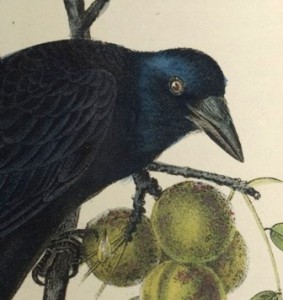Watch the Birdie . . .
One of the greatest habits a writer can develop is that of observation. Observation is a form of discovery — we look at the mundane, the ordinary, and because we pay attention to it we see it in a new way. A visual artist may sit down in front of something — say a crow — he’s seen a thousand times before, but this time, because of the attention he pays, the crow is not merely a black bird, but a bird with attitude, with personality. The artist watches the bird intently, notes the scaly texture of the naked-looking legs, each talon and the way that talon grips the branch; the artist sees not just black in those feathers, but purple, and midnight blue. He watches how the bird moves, clacks her beak, cocks her head, the expression in her eye. He draws one line, and then another, each detail coming together to create a whole, and something more than the mere static representation of “crow”. Because of the care, the attention, the details, this crow becomes not just “crow”, but that specific crow, the one with a taste for gooseberries, the one with a glint both mischievous and a little threatening in her eye.
This specificity is what we strive to do as writers as well, and we learn how to do it by observing. A terrific exercise is to go somewhere familiar — it can be your kitchen or your garden or the train station — and write down in your notebook a description of what’s in front of you. It need not be something large — this works as well for a single candlestick as it does for a carnival. Don’t write about feelings, opinions or thoughts — just write down what you can see, touch, taste, hear or smell. These will be details you can use later in your writing.
This is how we connect to the world, and the more connected to the world we are, the better our writing will be. It’s a fallacy that writers are people who live solely in our heads — we may spend a lot of time in our imaginations, but in order to have an imagination worth hanging out in, we have to fill it up with experiences and sense details.
In Morley Callaghan’s wonderful book, That Summer in Paris: Memories of Tangled Friendships With Hemingway, Fitzgerald, and Some Others, the authors reminisces about a time F. Scott Fitzgerald visited his apartment and was fascinated by the handkerchiefs Callaghan’s wife had laundered and spread out on the windowsill to dry. Mrs. Callaghan peeled one off the sill and folded it. Fitzgerald asked if he could do it. Here’s the passage:
Did women often do this? he asked. How simple and wonderful it was. Oh, he would certainly use it in a story. Day by day he sought out fresh little details like this one for use in his stories, he said.
That’s what we should be doing as well, if we want our writing to be alive and fresh. We should spend some time very day, looking for unexpected handkerchiefs drying on a sunny windowsill; we should take note of the glint in a hungry crow’s eye.

Lauren, thanks for an inspiring essay. What an interesting way to look at the world… makes much more sense than not really seeing what’s right in front of us. This applies to so many aspects of our lives. I admire your way with words. I don’t always post my feelings on your blog, but I have to let you know, I really love reading what you share.
Thanks so much, Lucky8. I appreciate you taking the time to comment.
I love really looking at the changes in nature.
I couldn’t agree more with your comments. As I paint, photograph, as well as write, it seems natural to be curious visually.
Fall is my favorite season. Living in the Western end of Canada, I am always fascinated by the varying sizes and colors of fallen leaves from maple trees. I often travel to a very small area near where I live and walk along the tree lined street checking out all the orange, red colors of the hundreds of leaves scattered on the sidewalk.
It makes me feel humbled by the repeated rituals of seasons and in awe of the miracle of this season changing from the heat of summer to the bare branches stark against the sky.
Occasionally, I’ll bring a few leaves home with me to enjoy, loving color as I do.
Thanks for your comment, Wendy. I can imagine those colorful leaves, as you describe them. . . lovely.